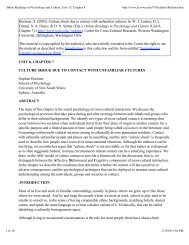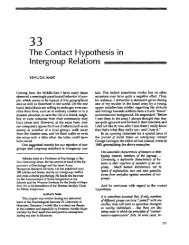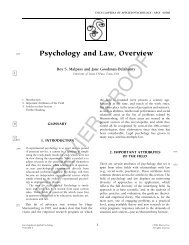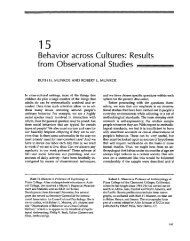The Longest War: Gender and Culture
The Longest War: Gender and Culture
The Longest War: Gender and Culture
You also want an ePaper? Increase the reach of your titles
YUMPU automatically turns print PDFs into web optimized ePapers that Google loves.
122 17/ <strong>The</strong> <strong>Longest</strong> <strong>War</strong>: <strong>Gender</strong> <strong>and</strong> <strong>Culture</strong><br />
ports anthropologist Gilbert Herdt (1984), all adolescent<br />
boys are required to engage in oral sex with<br />
older men as part of their initiation into manhood.<br />
Sambians believe that a boy cannot mature physically<br />
or emotionally unless he ingests another<br />
man's semen over a period of several years. However,<br />
Sambian parents would react with shock <strong>and</strong><br />
disbelief if a son said he wanted to live as a woman.<br />
Every man <strong>and</strong> woman in Sambian society marries<br />
someone of the other sex <strong>and</strong> performs the work<br />
assigned to his or her own sex; no exceptions.<br />
What these diverse reactions tell us is that although<br />
anatomical sex is universal <strong>and</strong> unchangeable<br />
(unless extraordinary surgical procedures are<br />
used), gender, which encompasses all the duties,<br />
rights, <strong>and</strong> behaviors a culture considers appropriate<br />
for males <strong>and</strong> females, is a social invention. It is<br />
gender, not anatomical sex, that gives us a sense of<br />
personal identity as male or female. <strong>Culture</strong>s have<br />
different notions about what gender roles should<br />
entail, how flexible these roles ought to be, <strong>and</strong> how<br />
much leeway males <strong>and</strong> females have to cross the<br />
gender divide.<br />
Perhaps, however, there is something essential<br />
about the sexes, something lying beneath the veneer<br />
of culture, immutable <strong>and</strong> eternal. That assumption<br />
is certainly widespread, <strong>and</strong> it has guided the research<br />
of social scientists as well as the beliefs of<br />
laypersons. Let us examine this assumption more<br />
closely. Are there some aspects of masculinity <strong>and</strong><br />
femininity that occur at all times <strong>and</strong> in all places<br />
If certain characteristics are common, why is that<br />
so What determines how men <strong>and</strong> women should<br />
act toward each other, what their rights <strong>and</strong> obligations<br />
should be, <strong>and</strong> what it means, in psychological<br />
terms, to be female or male<br />
SEARCHING FOR THE<br />
ESSENTIAL MAN<br />
AND WOMAN<br />
By comparing <strong>and</strong> contrasting different cultures<br />
around the world, social scientists have tried to<br />
identify those aspects of gender that are universally<br />
male or female. <strong>The</strong>ir efforts may sound pretty<br />
straightforward. However, because researchers, like<br />
everyone else, are influenced by their own deeply<br />
felt perceptions <strong>and</strong> convictions about gender, the<br />
topic has been one of the most complex to study<br />
cross-culturally<br />
For many years American <strong>and</strong> European researchers<br />
looked for <strong>and</strong> found evidence that pri-<br />
mate males (human <strong>and</strong> ape) were "by nature"<br />
competitive, dominant, <strong>and</strong> promiscuous, whereas<br />
primate females were "by nature" cooperative, submissive,<br />
<strong>and</strong> monogamous (Tavris, 1992). Because<br />
of their own preconceptions about male <strong>and</strong> female<br />
roles, based on their own cultural experiences,<br />
these observers often overlooked the evidence that<br />
contradicted their assumptions, even when the widence<br />
was in front of their noses.<br />
For example, many years ago the famous anthropologist<br />
Bronislaw Malinowski wrote a book<br />
on the Tmbri<strong>and</strong> Isl<strong>and</strong>ers, in which he concluded<br />
that males controlled the economic <strong>and</strong> political life<br />
of the community. (Another of his biases is glaringly<br />
apparent in the title he gave his book: <strong>The</strong><br />
Sexual Life of Savages.) But when Annette Weiner<br />
went to live among the Trobri<strong>and</strong>ers many years<br />
later, she learned, by talking to the women, what<br />
Malinowski had not: that there was an important<br />
economic underground controlled by the labor <strong>and</strong><br />
exchanges of women.<br />
Similarly, in 1951, another famous anthropologist,<br />
E. E. Evans-Pritchard, reported that among the<br />
Nuer, a tribe living in the Sudan, husb<strong>and</strong>s had<br />
unchallenged authority over their wives. Yet he<br />
himself described incidents in Nuer family life that<br />
contradicted his conclusion:<br />
[Should a Nuer wife1 in a quurrel with her husb<strong>and</strong><br />
disfigure him-knock a tooth out, for example-herfather<br />
must pay him compensation.<br />
I have myself on two occasions seen a father pay<br />
a heifer to his son-in-law to atone for insults<br />
hurled at the husb<strong>and</strong>'s head by his wife when<br />
irritated by accusations of adultery.<br />
We don't approve of domestic violence, nor do we<br />
think the wife's actions cancel out men's political<br />
power over women in Nuer culture. However, as<br />
anthropologist Micaela di Leonardo observes, a<br />
husb<strong>and</strong>'s authority in the home is not absolute if<br />
his wife can insult him <strong>and</strong> knock his teeth out, <strong>and</strong><br />
all he can do is dem<strong>and</strong> that his father-in-law fork<br />
over a cow!<br />
Many early researchers not only assumed that<br />
male dominance <strong>and</strong> aggression were universally<br />
the province of men; they also assumed that female<br />
nurturance was universally the province of women.<br />
Because of this assumption, Western researchers<br />
often overlooked the nurturing activities of men, or<br />
even defined nurturance in a way that excluded the<br />
altruistic, caring actions of men. When anthropologist<br />
David Gilmore (1991) examined how cultures







